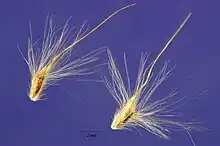Bothriochloa saccharoides
Bothriochloa saccharoides is a species of grass known by the common name silver bluestem.[2][3] It is native to the Americas, including Mexico, the Caribbean, and parts of Central and South America.[4]
| Bothriochloa saccharoides | |
|---|---|
 | |
| Seeds | |
| Scientific classification | |
| Kingdom: | Plantae |
| Clade: | Tracheophytes |
| Clade: | Angiosperms |
| Clade: | Monocots |
| Clade: | Commelinids |
| Order: | Poales |
| Family: | Poaceae |
| Subfamily: | Panicoideae |
| Genus: | Bothriochloa |
| Species: | B. saccharoides |
| Binomial name | |
| Bothriochloa saccharoides | |
This perennial bunchgrass grows to 2 to 3 feet in height. The leaves reach 8 inches long. The stems are often purplish toward the base. The inflorescence is white and hairy. The plant produces many seeds.[3]
This species is used for grazing cattle, especially in the spring before the inflorescences form. Goats eat the seed heads. The grass can be added to a hay mix.[2]
References
- NatureServe: Bothriochloa saccharoides
- USDA Plants Profile for Bothriochloa saccharoides
- Bothriochloa saccharoides. USDA NRCS Plant Fact Sheet.
- "Bothriochloa saccharoides". Germplasm Resources Information Network. Agricultural Research Service, United States Department of Agriculture. Retrieved 23 January 2018.
This article is issued from Wikipedia. The text is licensed under Creative Commons - Attribution - Sharealike. Additional terms may apply for the media files.
